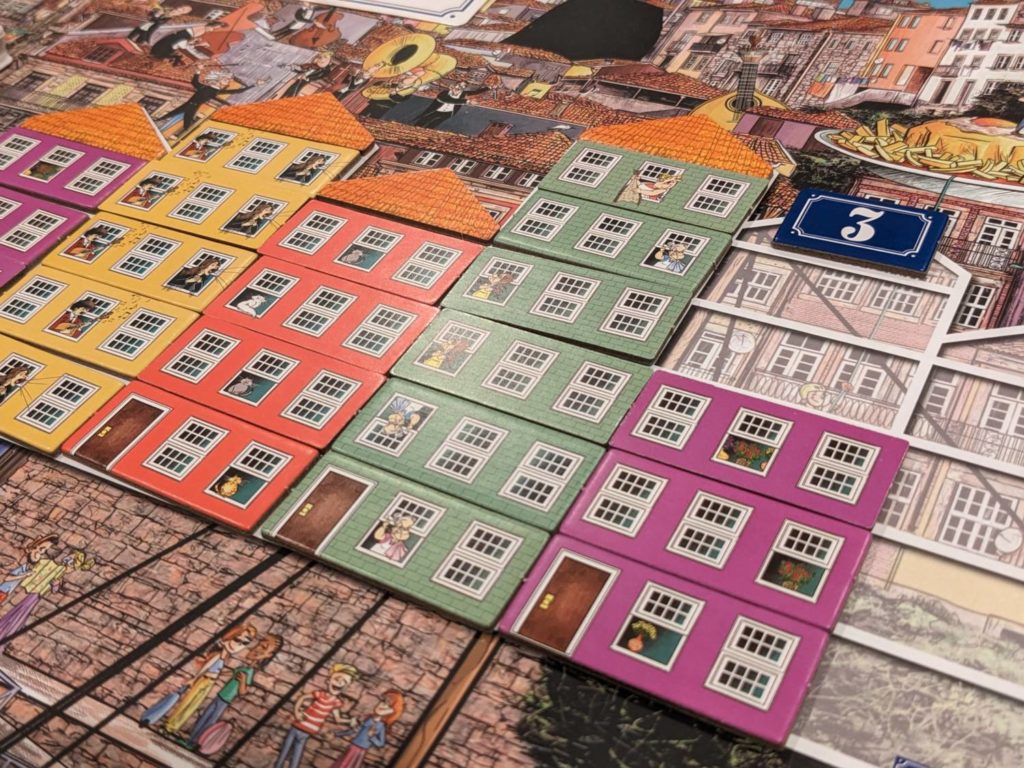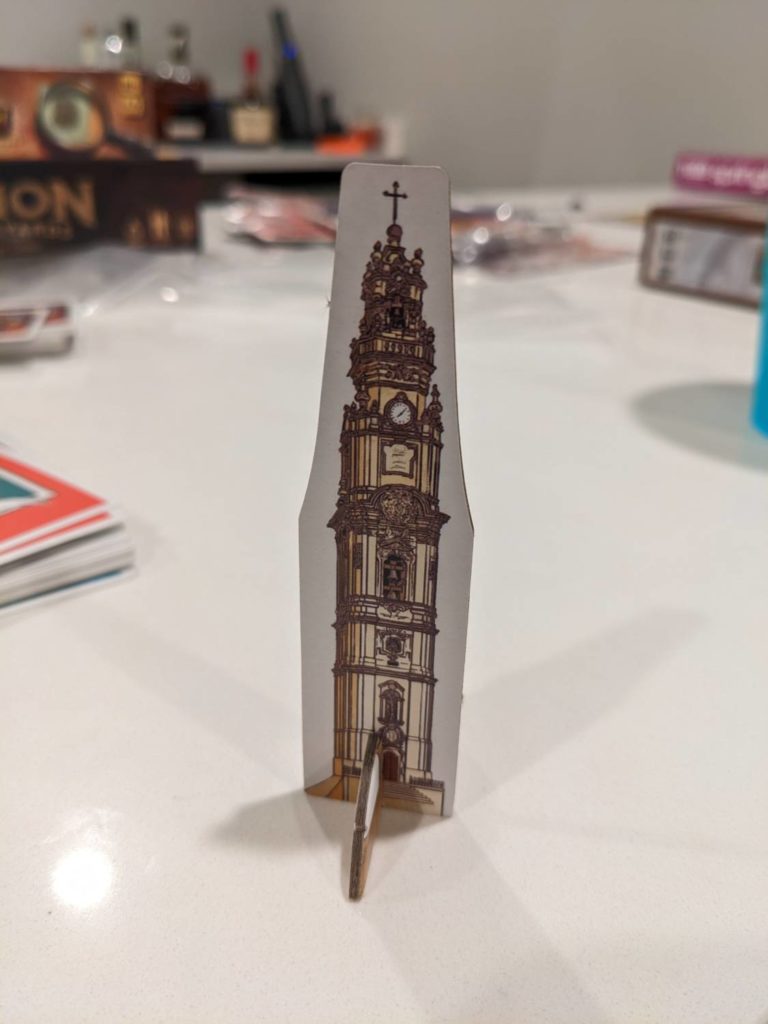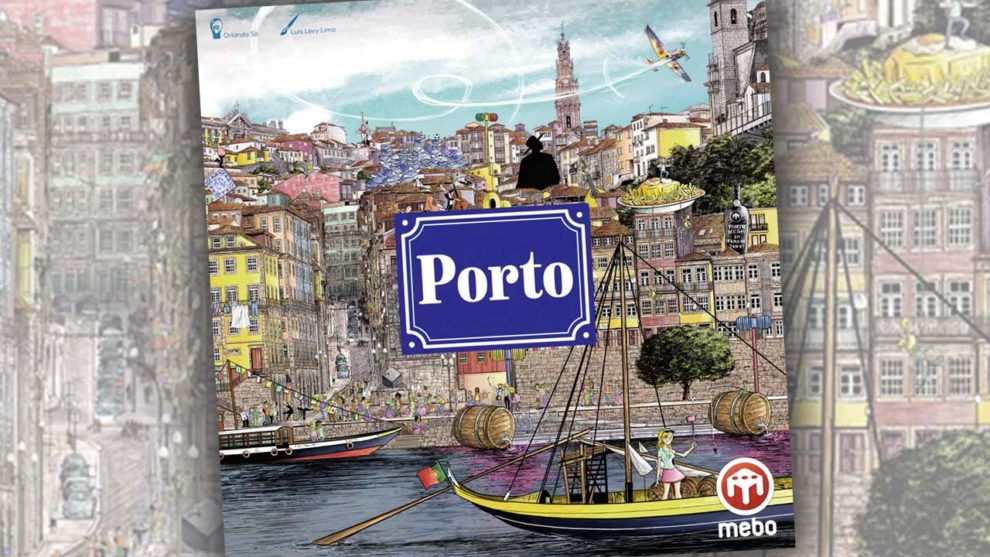Disclosure: Meeple Mountain received a free copy of this product in exchange for an honest, unbiased review. This review is not intended to be an endorsement.
I went to a friend’s house for game night recently. The first game of the night was the 2019 release Porto (Eagle-Gryphon Games), so I began to get the game’s components set up on the table.
Huge board, roughly the size of some of the other larger EGG productions designed by Vital Lacerda such as Kanban EV. Thick tiles, which serve as floors of various houses under construction in the Portuguese city of Porto. Beautiful artwork on a board relatively uncluttered, and thick cards used for personal goals and ongoing contracts.
Porto, like every other game I’ve had the chance to try from EGG, is a AAA production. (MEBO Games, the publishing partner for Porto, seems to have a physical component track record similar to EGG; their game Lisbon Tram 28 has a very similar vibe to the look and feel of Porto.)
Once I finished the setup, my two hosts marveled at the presence and shared that they were excited to play another “medium-to-heavyweight EGG experience.” However, they didn’t know what I knew: Porto is a very light, very quick tile-laying, hand management game that only took us 32 minutes to play after my five-minute teach.
“Hmm,” one of the players said. “I thought there would be more to it!”

Draw Cards, Build Houses
Porto is light enough to play with your grandparents—the ones who have not played any games besides gin rummy for the last 50 years.
Here’s how light the game is: while teaching that three-player game, one of the two other players didn’t bother to listen to my teach while typing away on his phone, distractedly picking up what little rules overhead there is. He still won that game!
Players are responsible for building floors in various houses in the city of Porto. After a certain number of houses are completed, that triggers the end of the game—finish out that round, then play one more full round. Most scoring takes place during the game, with a small amount of end-game points coming in the form of each player’s private goals.
Each turn of Porto allows players to take one of only two actions: draw cards or build floors. A market of five face-up cards is always available; cards come in five different colors (represent the five colors of floors that a house can take on), with one of three different values ranging from 1-3. A player can draw cards up to a total value of three from this market; that could be a single three card, or three one-value cards, or a combination of other values. There’s no limit to hand size.
The second option: build floors. This is the only way to score points during the game. By playing exactly two cards, players can build floors on one of the available houses on the map. They will do this by using one card for its number, and one card for its color.
Let’s say I want to play a green three and a red two card. This means that I can either:
- Build three red floors, OR
- Build two green floors.
Based on the decision, that player takes a number of tiles from the supply and lays those tiles in a house. Houses range from 4-6 floors, so no player can ever start and finish an empty building on their turn. Usually, they will start building a house, OR continue building a single house, OR finish a single house. No matter what, players get points for everything in Porto—there are bonuses for building a doorway. There are (usually) points for finishing a house and putting a roof on that house.
You’ll score points for every floor in the house. You’ll get points for floors built on a turn that are adjacent to floors built in previous turns. And you’ll get points from a rotating market of Contracts that reward everything from the color of the cards you just played to build, to the number and color of floors you built on that turn, or maybe even points if you finished a certain color of house on that turn.
Even though that sounds like a lot to manage in theory, it’s very, very simple to administer in practice. When a player knows where they want to build, it’s easy for the table to share in the accounting to make sure everyone gets the points they earned.
Turns fly around the table, and the available number of houses scales to the player count. Porto also has a solo mode, which is a nice way to learn the game. It also prepared me for the amount of randomness involved.

Set Expectations
Porto is a fancy 30-minute filler with a good amount of randomness thanks to the card draw. Despite the look and feel of a heavier experience, Porto is best served with a healthy dose of expectation setting: even before you break this out of the box, you’ll need to lean into your audience.
If you are playing with hardcore games, tell them the truth—the game is beautiful, but the decision making is very, very light. Some will be angry that their buddy Dakotah won the game because they got lucky with both the face-up building card drafts on their turns, and the timing of when they played cards out of their hand. If you are playing with “muggles”, talk down the intimidation factor. Porto looks like it will be dense, but once you show players how to build floors, much of the table anxiety will melt away. Either way, Porto is a breezy time at the table.
Beyond the issue that may arise in cases where expectations are not set, Porto had a couple of other issues. Card cycling is a minor headache here: someone will be changing out cards on every (short) turn, be it the general market of building cards or the contract cards.

I enjoy the general layout of the board, but the artwork feels like it distracts from the board, not always in a good way. For example, there are cool dragons, a woman on a boat with a selfie stick, pictures of people moving around Porto, and even the publisher logo in prominent positions. Why is all of this going on? I sense that culturally, this might excite someone who has been to Porto. For the rest of us, it feels like the artwork gets in the way.
Iconography in Porto is a mixed bag. The building cards with numbers and colors are easy. The public contract cards sometimes highlight that a single floor needs to be built to score points, but other cards require exactly two or three floors to be built in order to score. But the cards that highlight an opportunity to score when someone places a roof on a building? That shows exactly two floors being built, but it’s meant to symbolize any number of floors. Private goals have similar problems.
Luckily, the back of the rulebook calls out specifics on all of the cards, but there is only one rulebook. Players will need to check and re-check this appendix to assure that they are on track, particularly for the private goals (nothing beats thinking one thing for the entire game then realizing that you don’t, in fact, have that going for you!!).
Porto was an above-average time at the table, particularly for plays with casual gamers and my family. I don’t recommend this as a game for those who prefer heavier fare; there are better options for those looking for meaningful choices in a 30-to-45 minute playtime.











Add Comment